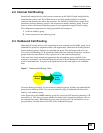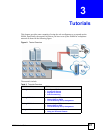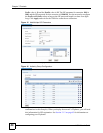
Chapter 2 How It Works
X6004 User’s Guide
38
• FXO (Foreign Exchange Office) Trunk - This type of outbound line group consists
of telephone cables connected to ports on an FXO interface card on the X6004. The
telephone cables lead to the PSTN (Public Switched Telephone Network), or in other
words your traditional (non-VoIP) telephone company. FXO ports always point in the
direction of the telephone services.
The figure below shows the relationship between FXS and FXO ports.
Figure 5 FXS and FXO Ports
• LCR (Least Cost Routing) - This is a rule which specifies which outbound line group is
used when making an outbound call. It consists of a dialing condition, for example dial 0
to make a call via a specific FXO trunk or dial 1 for calls via a SIP trunk. LCRs also set
priority to which outbound line group should be tried first, second, third and so on when
making outbound calls with the same dialing condition.
• Auto-Attendant - This is a feature which routes incoming calls to their proper extension.
An auto-attendant is assigned to each outbound line group and it services incoming calls
on those lines. If your organization has two outbound line groups, each with a specific
telephone number for incoming calls, then you can assign a different auto-attendant for
each incoming line. Assign one auto-attendant for general calls to the extensions in your
organization (for example AA1) and one auto-attendant for direct routing to a FAX
machine (for example FAX).
Figure 6 Auto-Attendant
FXO
FXO
FXS
FXS
PSTN
AA1
FAX
1001
1002
1003
2001
555-0001
555-0002
Please dial the
extension you
would like to
reach.


















